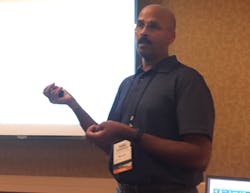Preparing for and Applying the Internet of Things
What could you do differently if the cost of sensing and communication costs reached zero? This is the question Andy Robinson of Avid Solutions asked at the start of his Internet of Things (IoT) application development session at the Wonderware 2015 Conference. His question is not a fanciful what-if proposition; it is a fast-approaching reality as interest in the IoT directly influences the level of Internet connectivity throughout industry and, therefore, the costs to connect systems within a plant and across the globe.
Hanu Kommalapati, senior director of program management at Microsoft, also spoke at the conference about extending industry capabilities with the use of IoT.
He noted that the principal driver he sees behind industry’s interest in IoT is not the appeal of the technology itself, but the fact that “any business that knows itself can be more proactive. Businesses are seeking greater self awareness,” he said.
In terms of real world IoT applications, Kommalapati said that companies tend to deploy these projects in a phased approach. “In the first stage, they connect to the cloud for telemetry—to monitor and track the device state and create basic rules to improve operational efficiency,” he said. “The next stage involves business intelligence—analyzing and visualizing the data collected from devices to discover patterns using predictive analytics and operationalizing those insights to improve processes in real time.”
Just as interest in IoT is changing industry, Kommalapati explained that it is also changing Microsoft. To illustrate this he highlighted the various versions of Windows 10 IoT—which range from Windows 10 IoT Core for small devices, to Windows 10 Mobile Enterprise for devices ranging from smartphones and tablets to barcode readers and other handheld mobile devices, to Windows 10 IoT Enterprise for industrial or commercial devices such as robotics systems, OEM machinery, and medical device equipment.
Shifting his focus to Micosoft’s Azure cloud service and how it supports the stages of IoT implementation, Kommalapati said that Azure’s Event Hubs support global device connectivity and management in the cloud using a high-scale telemetry ingestion service with HTTP/AMQP protocol support, which permits each Event Hub to handle up to 1 million publishers with 1 GB/sec ingress and manage 60+ terabytes of data a day. “If your device platform is not currently supported,” added Kommalapti, “you can use a field gateway and event-to-protocol adapter to translate that device’s data to the Event Hub.”
With this much data going into the cloud, security is an obvious concern. Kommalapati said this is why Microsoft is developing the Azure IoT Suite which can support the connection of millions of devices, handle their telemetry, and provide command and control, device registry and identification. He added that the Azure IoT Suite will also support MQTT (Message Queue Telemetry Transport), which happens to be one of Andy Robinson’s preferred methods of using Wonderware’s System Platform in IoT applications.
In his session, addressing the use of Wonderware System Platform in Internet of Things (IoT) applications, Robinson explained that he likes MQTT because of its light data use (headers are only 7 bytes), use of TLS and lack of an incoming connection to client for security, its three levels of quality of service, plus the fact that it is an accepted OASIS standard. In his session he also pointed out that MQTT, compared to HTTP, is 93x faster, uses 12x less battery power to send data, uses 171x less battery power to receive data, and uses 8x less network overhead.
Moving beyond the initial IoT implementation stage of device connectivity, Kommalapati touched on how Microsoft’s Azure Stream Analytics, HD Insight and Machine Learning leverage Hadoop for storing and analyzing data across hundreds or even thousands of nodes. For presentation of these systems’ data and business connectivity to it, he highlighted the role of Microsoft Dynamics and BizTalk services.
Considering the example being set by Wonderware and Microsoft around their ongoing IoT-related advances, manufacturers looking to employ IoT solutions to improve their operations will find the necessary tools are now available and becoming easier to use.
About the Author
David Greenfield, editor in chief
Editor in Chief

Leaders relevant to this article:
